Weather lore: What's the science?
- Published
- comments
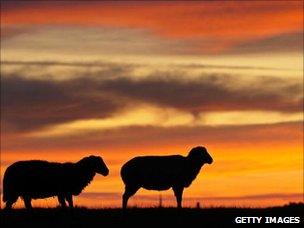
Do shepherds really delight in red skies at night?
Will it rain on your picnic/camping trip/festival? Old weather sayings may sound like fanciful folklore, but some can help amateur forecasters. Here are six that are backed up by science.
Is there any truth to weather sayings, or are they merely a whimsical interpretation of reality?
Some of the earliest examples of weather lore date back to the Bible. With farmers and mariners so dependent on the weather, we have undoubtedly been looking for signs from the heavens since the dawn of man.
Forecasting the weather accurately can be a challenge, even with today's supercomputers.
But an experienced weather observer can get a fairly good idea of an impending storm well in advance, just by looking at the sky. The signs can be clearer than you think.
Over the millennia we have learnt to recognise these patterns, and a rhyme handed down from generation to generation is a good way to share and remember knowledge - especially in the days before literacy was widespread.
While many old sayings are unreliable and of little practical use, here is the meteorological logic behind six traditional weather rhymes.
<bold>1. "Red sky at night, shepherd's delight; red sky in the morning, shepherd's warning"</bold>
Deep red sunsets are often associated with dry, settled weather and high pressure. A deep red sunset may indicate a prolonged spell of good weather. But the key sign is in the red sky around the sun - and not the colour of the cloud itself.
Red sky in the morning can be interpreted in a slightly different way. As the sun rises at a low angle in the east, it may light up the impending clouds associated with a weather front coming in from the west.
It may also indicate that rain is on its way and due to arrive later in the day, hence the "shepherd's warning".
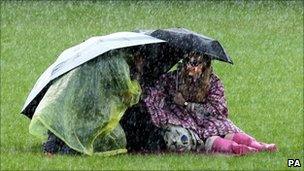
It may not feel like it, but it will stop
<bold>2. "Three days rain will empty any sky"</bold>
This saying is very much open to anyone's interpretation, but the simplest logic behind it is that, in our climate, heavy rain doesn't really last for very long.
Cloudy and gloomy weather may persist for many days at a time, but torrential rain usually clears in a day or two, and almost certainly in three.
<bold>3. "When the wind is out of the east, tis neither good for man nor beast"</bold>
This is a classic weather rhyme and an easy one to interpret for meteorologists in the UK and in any other part of Europe.
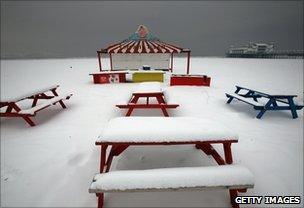
Siberia? No, Weston-Super-Mare
It simply implies that our harsh winter weather usually comes in from eastern Europe and Russia. A strengthening icy wind blowing from the east would indicate to a farmer hundreds of years ago that snow and frigid conditions were on the way.
Cold "easterlies" often bring spells of heavy snow to eastern Britain, but the wind chill from a cutting Siberian wind is felt right across the country. In the summer months, on the other hand, an easterly wind may carry pollutants and poor quality air from the near continent, giving us hazy skies. However, the latter link is more open to debate.
<bold>4. "In the morning mountains, in the afternoon fountains" </bold>
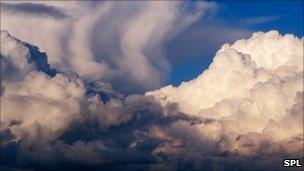
A sky filled with building thunder clouds
Clouds building through the morning are often followed by thunderstorms in the afternoon.
Thunder clouds and heavy showers often develop in a set pattern, especially in the summer months. As the sun heats the ground and air during the morning, small cumulus clouds appear in the sky.
If atmospheric conditions are just right, these will rapidly grow into towering cauliflower-like mountains. By the afternoon, the clouds will have reached the dizzy heights of the top of the atmosphere, resulting in rain and lightning below.
<bold>5. "If a circle forms 'round the moon, 'twill rain or snow soon"</bold>
Rain in the UK is usually associated with a weather front or big shower clouds - it's typically one or the other.
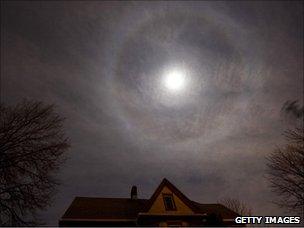
A lunar halo in an icy sky
Weather fronts come in all shapes and sizes and travel at different speeds, but they have one thing in common - their structure. Just like a house needs foundations and a roof, a weather front has a base and a top. The top, or leading edge, of a weather front can be sometimes be seen in the distant horizon or high in the sky, well before the rain arrives.
The cloud layer that makes the top of the weather front is easily recognisable if you know what to look for. It's a thin, wispy or hazy layer made of ice crystals and known to weather forecasters as cirrostratus.
This layer of ice crystals in the night sky can create an optical phenomenon called a lunar corona - a circle of colours surrounding the moon. Hence, the idea that a weather front is approaching and rain is on the way.
<bold>6. "Cold night stars bright"</bold>
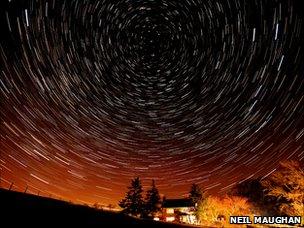
Clear skies are the coldest
This is one of the easiest rhymes for anyone to interpret.
Clear night skies usually bring a chill to the air. As clouds act as blankets, without them heat stored in the earth's surface during the day escapes into the atmosphere.
When stars are particularly bright, it may indicate very dry, unpolluted air which often arrives from the Arctic. Therefore, one would expect that a particularly cold and clear night is due to air originating from the far north.
<bold>BBC One's </bold> <link> <caption>The Great British Weather</caption> <url href="http://www.bbc.co.uk/programmes/b0129tgz" platform="highweb"/> </link> <bold> starts on Wednesday 13 July at 1930 BST. </bold>